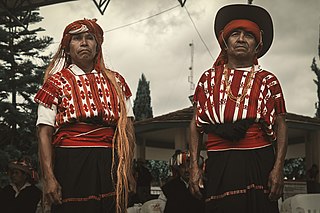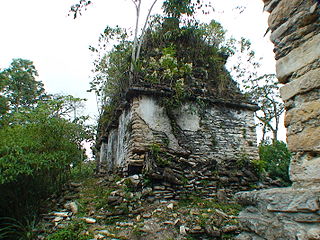
Chiapas, officially the Free and Sovereign State of Chiapas, is one of the states that make up the 32 federal entities of Mexico. It comprises 124 municipalities as of September 2017 and its capital and largest city is Tuxtla Gutiérrez. Other important population centers in Chiapas include Ocosingo, Tapachula, San Cristóbal de las Casas, Comitán, and Arriaga. Chiapas is the southernmost state in Mexico, and it borders the states of Oaxaca to the west, Veracruz to the northwest, and Tabasco to the north, and the Petén, Quiché, Huehuetenango, and San Marcos departments of Guatemala to the east and southeast. Chiapas has a significant coastline on the Pacific Ocean to the southwest.

Palenque, also anciently known in the Itza Language as Lakamhaʼ, was a Maya city state in southern Mexico that perished in the 8th century. The Palenque ruins date from ca. 226 BC to ca. 799 AD. After its decline, it was overgrown by the jungle of cedar, mahogany, and sapodilla trees, but has since been excavated and restored. It is located near the Usumacinta River in the Mexican state of Chiapas, about 130 km south of Ciudad del Carmen, 150 meters (490 ft) above sea level. It is adjacent to the modern town of Palenque, Chiapas. It averages a humid 26°C (79°F) with roughly 2,160 millimeters (85 in) of rain a year.

Popol Vuh is a text recounting the mythology and history of the Kʼicheʼ people of Guatemala, one of the Maya peoples who also inhabit the Mexican states of Chiapas, Campeche, Yucatan and Quintana Roo, as well as areas of Belize, Honduras and El Salvador.

Jean-Frédéric Maximilien de Waldeck was a French antiquarian, cartographer, artist and explorer. He was a man of talent and accomplishment, but his love of self-promotion and refusal to let the truth get in the way of a good story leave some aspects of his life in mystery.

Ignatius Loyola Donnelly was an American Congressman, populist writer, and fringe scientist. He is known primarily now for his fringe theories concerning Atlantis, Catastrophism, and Shakespearean authorship. These works are widely regarded as examples of pseudoscience and pseudohistory. Donnelly's work corresponds to the writings of late-19th and early-20th century figures such as Helena Blavatsky, Rudolf Steiner, and James Churchward.

Kʼinich Janaab Pakal I, also known as Pacal or Pacal the Great, was ajaw of the Maya city-state of Palenque in the Late Classic period of pre-Columbian Mesoamerican chronology. He acceded to the throne in July 615 and ruled until his death. Pakal reigned 68 years—the fifth-longest verified regnal period of any sovereign monarch in history, the longest in world history for more than a millennium, and still the longest of any residing monarch in the history of the Americas. During his reign, Pakal was responsible for the construction or extension of some of Palenque's most notable surviving inscriptions and monumental architecture. Pakal is perhaps best known in popular culture for his depiction on the carved lid of his sarcophagus, which has become the subject of pseudoarchaeological speculations.

Abbé Charles-Étienne Brasseur de Bourbourg was a noted French writer, ethnographer, historian, archaeologist, and Catholic priest. He became a specialist in Mesoamerican studies, travelling extensively in the region. His writings, publications, and recovery of historical documents contributed much to knowledge of the region's languages, writing, history and culture, particularly those of the Maya and Aztec civilizations. However, his speculations concerning relationships between the ancient Maya and the lost continent of Atlantis inspired Ignatius L. Donnelly and encouraged the pseudo-science of Mayanism.

The Usumacinta River is a river in southeastern Mexico and northwestern Guatemala. It is formed by the junction of the Pasión River, which arises in the Sierra de Santa Cruz and the Salinas River, also known as the Rio Chixoy, or the Rio Negro, which descends from the Sierra Madre de Guatemala. It defines part of the border between Guatemala and the Mexican state of Chiapas, then continues its northwesterly course, meandering through the Mexican state of Tabasco to the Gulf of Mexico.

The Tzotzil are an Indigenous Maya people of the central highlands of Chiapas, Mexico. As of 2000, they numbered about 298,000. The municipalities with the largest Tzotzil population are Chamula (48,500), San Cristóbal de las Casas (30,700), and Zinacantán (24,300), in the Mexican state of Chiapas.

Atlantis: The Antediluvian World is a pseudoarchaeological book published in 1882 by Minnesota populist politician Ignatius L. Donnelly. Donnelly considered Plato's account of Atlantis as largely factual and suggested that all known ancient civilizations were descended from this lost land through a process of hyperdiffusionism.

Mayanism is a non-codified eclectic collection of New Age beliefs, influenced in part by Pre-Columbian Maya mythology and some folk beliefs of the modern Maya peoples.

Francisco Javier Clavijero Echegaray, SJ was a Mexican Jesuit teacher, scholar and historian. After the expulsion of the Jesuits from Spanish provinces in 1767, he went to Italy, where he wrote a valuable work on the pre-Columbian history and civilizations of Mesoamerica and the central Mexican altiplano.

The Lacandon Jungle is an area of rainforest which stretches from Chiapas, Mexico, into Guatemala. The heart of this rainforest is located in the Montes Azules Biosphere Reserve in Chiapas near the border with Guatemala in the Montañas del Oriente region of the state. Although much of the jungle outside the reserve has been cleared, the Lacandon is still one of the largest montane rainforests in Mexico. It contains 1,500 tree species, 33% of all Mexican bird species, 25% of all Mexican animal species, 56% of all Mexican diurnal butterflies and 16% of all Mexico's fish species.

Frontera Corozal is a mostly Ch’ol community located in the Mexican state of Chiapas on the Usumacinta River, which separates it from neighboring Guatemala. The community was founded in the 1970s by families migrating from northern Chiapas. It is known for its dock with boats called lanchas which ferry people to the otherwise inaccessible Mayan ruins of Yaxchilan as well as to Bethel, Guatemala. It is also home to a regional museum, which is centered on two steles found nearby at Dos Caobas. The community is located in the Lacandon Jungle, surrounded by tropical rainforest, but this area has suffered severe damage. There have been recent efforts to promote conservation here, especially on communally owned lands. As of 2010, the town of Frontera Corozal had a population of 5,184.

Edward King, Viscount Kingsborough was an Irish antiquarian who sought to prove that the indigenous peoples of the Americas were a Lost Tribe of Israel. His principal contribution was in making available facsimiles of ancient documents and some of the earliest explorers' reports on pre-Columbian ruins and Maya civilisation.

Palenque is a city and municipality in the Mexican state of Chiapas in southern Mexico. The city was named almost 200 years before the nearby Mayan ruins were discovered in the 18th century. The area has a significant indigenous population, mostly of the Ch'ol people, a Mayan descendant. The city is the only urban area in a municipality of over 600 communities, and is surrounded by rainforest. Deforestation has had dramatic effects on the local environment, with howler monkeys occasionally seen in the city as they seek food. While most of the municipality's population is economically marginalized, working in agriculture, the Palenque archeological site is one of the most important tourist attractions for the area and the state of Chiapas. It is the poorest major city in the state of Chiapas.

Ricardo Almendáriz was a Guatemalan draftsman who accompanied Antonio del Río to the first excavation of pre-Columbian Maya ruins at Palenque in Chiapas, Mexico. Undertaken in May and June 1787, the expedition was performed under orders from Charles III of Spain, to investigate reports about the ruins from the inhabitants of the neighboring pueblo of Santo Domingo de Palenque. The team spent two weeks digging at the location, followed by three weeks studying the site.
Antonio del Río was a captain who led the first excavation of the Mayan ruins of Palenque in Chiapas, Mexico. The expedition was undertaken in 1787 for Charles III of Spain, following reports of the ruins from native inhabitants. It took the team two weeks to dig, and it then spent three weeks studying the site. He was accompanied by Ricardo Almendáriz who created drawings of the ruins still considered scientifically useful.

The Tzeltal are a Maya people of Mexico, who chiefly reside in the highlands of Chiapas. The Tzeltal language belongs to the Tzeltalan subgroup of Maya languages. Most Tzeltals live in communities in about twenty municipalities, under a Mexican system called “usos y costumbres” which seeks to respect traditional indigenous authority and politics. Women are often seen wearing traditional huipils and black skirts, but men generally do not wear traditional attire. Tzeltal religion syncretically integrates traits from Catholic and native belief systems. Shamanism and traditional medicine is still practiced. Many make a living through agriculture and/or handcrafts, mostly textiles; and many also work for wages to meet family needs.

Sak tzʼi is an archaeological site of the pre-Columbian Maya civilization. It is located in the municipality of Ocosingo of the Mexican state of Chiapas. The ruins are notable for having the earliest urban remains in the Upper Usumacinta region, as well as a unique ancient theater for elite use. The ancient identity of the site is subject to debate.



















